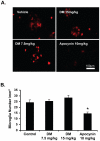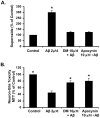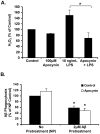Chronic apocynin treatment attenuates beta amyloid plaque size and microglial number in hAPP(751)(SL) mice
- PMID: 21655287
- PMCID: PMC3105011
- DOI: 10.1371/journal.pone.0020153
Chronic apocynin treatment attenuates beta amyloid plaque size and microglial number in hAPP(751)(SL) mice
Abstract
Background: NADPH oxidase is implicated in neurotoxic microglial activation and the progressive nature of Alzheimer's Disease (AD). Here, we test the ability of two NADPH oxidase inhibitors, apocynin and dextromethorphan (DM), to reduce learning deficits and neuropathology in transgenic mice overexpressing human amyloid precursor protein with the Swedish and London mutations (hAPP(751)(SL)).
Methods: Four month old hAPP(751)(SL) mice were treated daily with saline, 15 mg/kg DM, 7.5 mg/kg DM, or 10 mg/kg apocynin by gavage for four months.
Results: Only hAPP(751)(SL) mice treated with apocynin showed reduced plaque size and a reduction in the number of cortical microglia, when compared to the saline treated group. Analysis of whole brain homogenates from all treatments tested (saline, DM, and apocynin) demonstrated low levels of TNFα, protein nitration, lipid peroxidation, and NADPH oxidase activation, indicating a low level of neuroinflammation and oxidative stress in hAPP(751)(SL) mice at 8 months of age that was not significantly affected by any drug treatment. Despite in vitro analyses demonstrating that apocynin and DM ameliorate Aβ-induced extracellular superoxide production and neurotoxicity, both DM and apocynin failed to significantly affect learning and memory tasks or synaptic density in hAPP(751)(SL) mice. To discern how apocynin was affecting plaque levels (plaque load) and microglial number in vivo, in vitro analysis of microglia was performed, revealing no apocynin effects on beta-amyloid (Aβ) phagocytosis, microglial proliferation, or microglial survival.
Conclusions: Together, this study suggests that while hAPP(751)(SL) mice show increases in microglial number and plaque load, they fail to exhibit elevated markers of neuroinflammation consistent with AD at 8 months of age, which may be a limitation of this animal model. Despite absence of clear neuroinflammation, apocynin was still able to reduce both plaque size and microglial number, suggesting that apocynin may have additional therapeutic effects independent of anti-inflammatory characteristics.
Conflict of interest statement
Figures





References
Publication types
MeSH terms
Substances
Grants and funding
LinkOut - more resources
Full Text Sources
Other Literature Sources
Medical
Molecular Biology Databases

